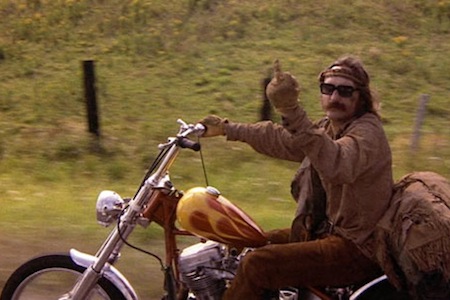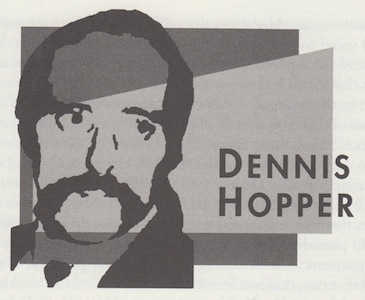
Born: May 17, 1936, Dodge City, KS
Died: May 29, 2010, Venice, CA
The whole Hollywood establishment had to stop and reassess, because at the exact time Easy Rider came up, Hollywood had just sunk millions into several very big clunkers, and here comes this film making a fortune. It changed the industry.
—Paul Schrader
As a member of the cast of Rebel Without a Cause (1955) and a close friend of James Dean, Dennis Hopper belonged to a generation intent on revolting against the homogeneous middle-class lifestyle that America embraced in the 1950s. His direct and forceful personality marked him as a difficult star and isolated him from the major studios. Working outside the bureaucracy, Hopper developed a new perspective on films that would bridge the gap between old pros and young fans; eventually it would also put Hopper back in the graces of the studios.
From the beginning of his career, Hopper sought roles that would not stereotype him. His rebellious nature found companionship among other actors training at Lee Strasberg’s Actors Studio. During work on Henry Hathaway’s From Hell to Texas (1958), Hopper experienced difficulty in finishing a scene and insisted on more than a hundred takes of his improvisational techniques. Hathaway was furious; the studio was furious. Hopper was relegated to B-movie roles for the next ten years.
At the same time, studios were out of sync with young adults, a fast-growing slice of the moviegoing market. Hollywood’s best attempts to attract them were films like Doctor Dolittle (1967), Paint Your Wagon (1969) and Hello, Dolly! (1969). Such films failed repeatedly, and Hollywood honchos began paying closer attention to the ideas of Dennis Hopper.
Editor’s note: The essays of Scott Smith’s 1998 book, The Film 100, are being republished in their entirety here on Keyframe, not as the last word on cinema, but as a starting point for further discussion. Please join the conversation. To view the entire Film 100 list and find links to all the essays, please visit Reintroducing the Film 100.
“The only thing you can make with a big budget is a big, dishonest, impersonal movie,” Hopper told them. To reinforce his point, he conceived a film that would serve as a low-budget attack on societal norms. He approached producer Roger Corman about a psychedelic road movie that would deliberately embrace the hippie aesthetic. When Corman passed on the idea, Hopper financed the film himself, and the anti-establishment Easy Rider (1969) became his first attempt at directing. Hailed as a new direction in film, it was co-written by Terry Southern, who collaborated with Stanley Kubrick on Dr. Strangelove (1964). It cost $400,000 to make and won raves at the Cannes festival before opening to sellout audiences in the States. It became a monumental hit, making more than $16 million and dramatically changed the tone of pictures in the following decades, demonstrating to Hollywood that the future audience with the discretionary spending power would be youths, who wanted films whose style and issues reflected their own.
The success of Easy Rider ushered in a wave of such new films. Baffled film executives witnessed the notorious sequences of Peter Fonda, Jack Nicholson and Hopper consuming hallucinogenic drugs in a New Orleans cemetery and realized they had to hire a younger batch of directors to make the kinds of films teenagers would find interesting. They searched the film schools for talent; among their notable discoveries were Bob Rafelson, Steven Spielberg, Martin Scorsese, Peter Bogdanovich, Francis Ford Coppola and George Lucas.
Ironically, Hopper was not one of the directors courted. He continued producing independently and directed two more films, showing only slight signs of his Easy Rider talent: The American Dreamer (1971) and the experimental, drug-induced The Last Movie (1971). The latter film had critics reporting Hopper’s early death as a trend-setting artist.
Throughout the seventies, as a serious drug habit and vocal outbursts made him unattractive to most U.S. productions, Hopper became a creative globetrotter. For the next fifteen years, his film work was done in such films as Australia’s Mad Dog Morgan (1976), West Germany’s The American Friend (1977) and France’s The Sorcerer’s Apprentices (1977).
Hopper temporarily enjoyed a comeback when Francis Ford Coppola ast him (some say typecast him) as an edgy photojournalist in the Vietnam epic Apocalypse Now (1979). The film’s antiwar message was a perfect fit with Hopper’s history as the voice of the sixties. Several 1986 performances—in Blue Velvet, Hoosiers and River’s Edge—propelled another comeback. Hopper then found opportunities to direct again with Colors (1986) and The Hot Spot (1990).
Playing a series of flipped-out villains turned Hopper into an eccentric character actor, and many film buffs are not aware of the magnitude of his influence. But his uneven career cannot change the fact that in one shining moment he had a hunch that, when acted upon, instituted a phenomenal shift in popular culture.
To read all the republished articles from ‘The Film 100,’ go to Reintroducing the Film 100 here on Keyframe.




